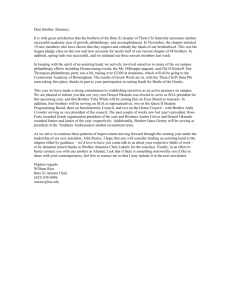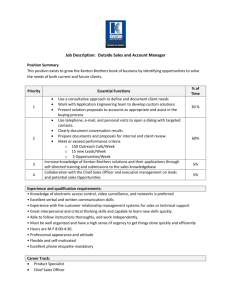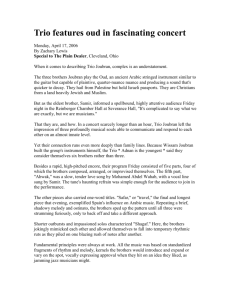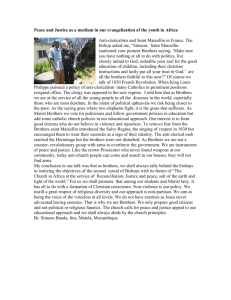The Christian Brothers, District of Toronto, 1851-1951
advertisement
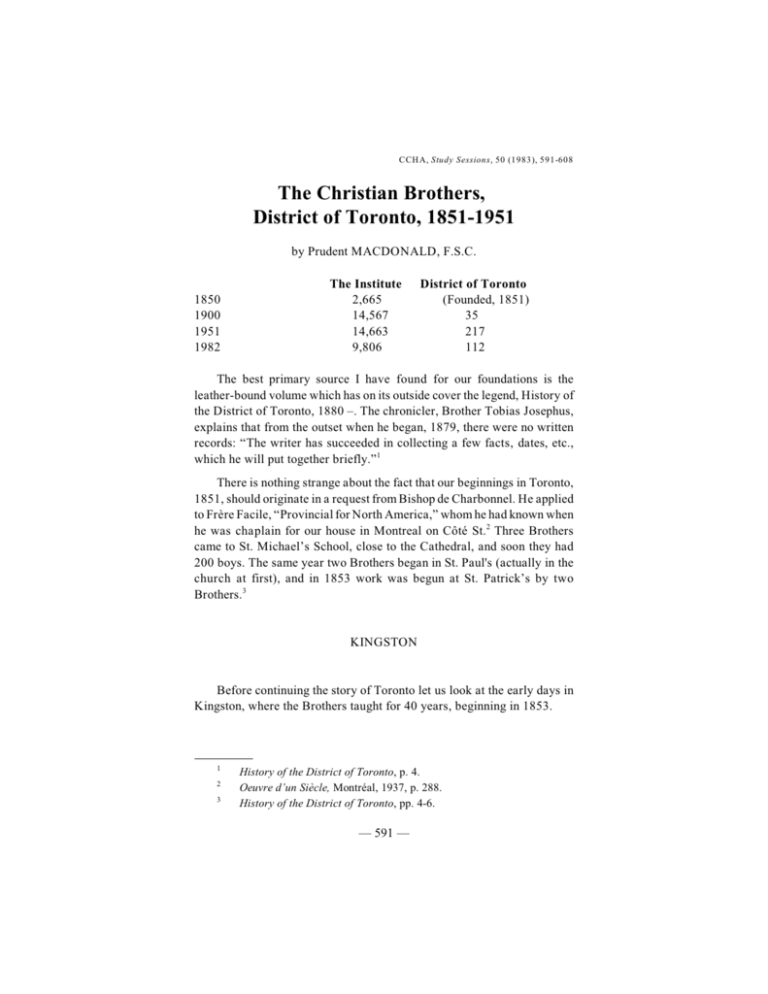
CCH A, Study Sessions, 50 (1983), 591-608 The Christian Brothers, District of Toronto, 1851-1951 by Prudent MACDONALD, F.S.C. 1850 1900 1951 1982 The Institute 2,665 14,567 14,663 9,806 District of Toronto (Founded, 1851) 35 217 112 The best primary source I have found for our foundations is the leather-bound volume which has on its outside cover the legend, History of the District of Toronto, 1880 –. The chronicler, Brother Tobias Josephus, explains that from the outset when he began, 1879, there were no written records: “The writer has succeeded in collecting a few facts, dates, etc., which he will put together briefly.” 1 There is nothing strange about the fact that our beginnings in Toronto, 1851, should originate in a request from Bishop de Charbonnel. He applied to Frère Facile, “Provincial for North America,” whom he had known when he was chaplain for our house in Montreal on Côté St.2 Three Brothers came to St. Michael’s School, close to the Cathedral, and soon they had 200 boys. The same year two Brothers began in St. Paul's (actually in the church at first), and in 1853 work was begun at St. Patrick’s by two Brothers.3 KINGSTON Before continuing the story of Toronto let us look at the early days in Kingston, where the Brothers taught for 40 years, beginning in 1853. 1 2 3 History of the District of Toronto, p. 4. Oeuvre d’un Siècle, Montréal, 1937, p. 288. History of the District of Toronto, pp. 4-6. — 591 — The records, in longhand, are among the most complete we have, but even here the original scribe, Brother Owen, states that nothing had been set down until 1872, almost 20 years after the foundation. One of the curious circumstances related in the early history of the Kingston community is that the Brothers were required to accept non-Catholic pupils, and to qualify as teachers: “When the Brothers arrived in Kingston, all the schools were under the control of the Government and administered by Protestant trustees. For this reason the Brothers were obliged to receive children of both persuasions as both had equal rights. “According to the terms of the School Act all teachers were obliged to submit to an examination.” 4 The account goes on to say that when the examination was held in the Court Room and in the presence of such dignitaries as the Catholic and Anglican Bishops, “the Brothers came forth honorably from the public trial.” And the writer expresses the opinion that this success was responsible in part for the subsequent establishment of a separate school board in Kingston. A new year opened in 1864 with the appointment of Brother Arnold as head of the school. One of his most successful initiatives was to prepare the boys for public examinations so as “to have the Catholic schools able to compete with the Common Schools.” 5 This public test was not only a great success, but it was followed by an exhibition to which were invited not only the Bishop of Kingston, but “those of Montreal, Ottawa and Sandwich.” One of the major attractions was “the Brothers' Boys’ Band of Montreal, under the leardership of Brother Tertullian.” The local impact was so great that it was resolved to collect subscriptions and have a band of their own. Some days later the Bishop called on Brother Arnold, gave him a statuette of the Pope, and said that he (B. A.) “had done more to unite Orangemen and Catholics together than any other man in the city.” 6 It might interest the affluent society of to-day to learn that in 1866 the Brother Provincial, considering the annual salary of the Brothers, $140.00, too low, made a successful appeal to the board to have it raised, to $180.00, “payments to be made quarterly.” Some of the difficulties of the Brothers with the board have a comical aspect, at least to the reader of to-day. A new Chairman decided to save 4 5 6 History of Kingston, p. 1 Ibid., p. 14. Ibid., p. 14. — 592 — money by refusing to supply wood to heat the Brothers’ house in winter, claiming that the board was obliged to heat only the school. The Director protested. When cold weather came, “he sent a large supply of green wood.” 7 On April 4, 1876 the High School Inspector visited the school of the Brothers. His report was as follows: Visited this school to-day. Was much pleased with the answering of the pupils in Grammar and Arithmetic. The writing, reading and spelling were good. The Order was very good. I was much pleased with the Principal’s recitation. J.A. MACLELLAN, LL.D., Inspector of High Schools. A similar transcript of the Inspector’s report about a year later praised the work of the school, but protested that more teachers were needed – only 4 Brothers for 350 boys! By 1881 evidently help had come. The personnel list of the community, headed by Brother Halward, consisted of 6 men. As has been indicated, there were occasional difficulties between the Brothers and the school board. In 1893 the community was notified that the board was dispensing with its services for two reasons: the board was not consulted on changes in personnel; and the Brothers did not see fit to prepare the boys for the Entrance to High School examinations. The withdrawal of the community was a matter of regret to many, including Archbishop Cleary, but the Kingston mission was ended. TORONTO We now return to the story of the Brothers in Toronto. A new type of school, a Commercial Academy, was opened in 1863. “There were two classes, both under the patronage of the Roman Catholic School Board.” 8 Fees were charged, not very high by our standards: $6.00 per quarter for 7 8 Ibid., p. 24. History of the District of Toronto, p. 9. — 593 — the first (or higher) class, and $4.00 for the second. The fees went to the board, which paid the salaries of the Brothers. In 1867 Brother Arnold was appointed Director of the Academy. The school was growing so rapidly that more space was needed. In 1870 the Bank of Upper Canada building at the corner of Duke Street and George was purchased, and the institution was called De La Salle Institute. A large addition in 1871 provided room for boarders “from distant parts of the United States and Canada.” 9 The good name of the Institute was enhanced by “dramatic and musical entertainments” in which the band and the orchestra displayed their skill, and by public examinations. But while this institution was expanding, things were not going well in the primary schools. In 1876 a report given by Inspector Buchan “was anything but complimentary to the Brothers’ schools. Bad spelling was found in the attendance registers.” The chronicles reports that this unfortunate state of affairs “served as an impetus to the Brothers and Trustees.” In fact, two years later, on May 9th, the Minister of Education, Hon. Adam Crooks, “visited all the Brothers' schools, and everywhere spoke in the most flattering terms of the proficiency of the children and the ability of the teachers.” 10 It is interesting to note that in those days the general public found school activities quite attractive. Thus, at the Graduation for the Commercial Diploma at De La Salle Institute on June 21, 1878 the students were examined in public. On this occasion “several business gentlemen of the city were present and examined critically. The answers were most satisfactory. At the annual Commencement a few days later the principal feature of the programme was a debate.” 11 It might be well to indicate here the numbers of teachers and students in Toronto in 1878: De La Salle Institute had a staff of eight, St. Mary’s School had four Brothers, St. Paul’s and St. Patrick’s had three each, St. Michael’s had two. A delegation of the Roman Catholic School Board visiting the “Brothers' Free Schools” on December 10 “were very favourably impressed with what they saw.” 12 The four elementary schools had 692 pupils present. De La Salle Institute had 37 boarders and 67 day students. 9 10 11 12 Ibid., p. 10. Ibid., p. 17. History of the District of Toronto, p. 18. Ibid., p. 21. — 594 — OTTAWA Let us glance now at the rather brief sojourn of the Brothers in St. Patrick's Parish, Ottawa. It began about this time, and the opening lines of the history are fairly typical. In September of 1877 Brothers Abnis of Mary and Menander of Mary started to teach in the basement of the church while awaiting the completion of the school. The writer says that although the premises were gloomy and unattractive, the Brothers were pleased by the “neatness and docility of the children.” The assistant pastor, Father Whelan, was most encouraging, enabling the Brothers to stage concerts in the parish hall “opposite the Basilica” in order to raise money to furnish the new school, described as “a shell.” Word got around, and soon “Doctor O’Connor and Mr. Esmond and others gave substantial proof of their interest in the school.” 13 Three High School inspectors made a visit, and “in general the reports of these gentlemen were satisfactory.” 14 By 1889 the Brothers, now a five-man community, got a house of their own at 353 McLaren Street. Father Whelan, ever the benefactor, came to bless the house and promised to come once a week as confessor to the community. And his kindness was not limited to spiritual favours. The record attests that at times he would send the Brothers “a dozen of ale” or a turkey. When Inspector Donovan made his visit on December 3, 1889, he said that the school was the best of the boys’ classes in the city, but inferior to the girls’ classes. 15 By the year 1891 a decline had set in throughout the District, many houses being closed, and one of the casualties was St. Patrick's, Ottawa. ST. CATHARINES In chronological order we should next look at St. Catharines, Ontario. The history opens with the fall of 1878, when there were four Brothers on the staff, three teachers and one “employed in the kitchen.” The usual problems of establishing good relations with the clergy and the school board were happily solved. It is a bit surprising for us to learn that when the 13 14 15 History of St. Patrick’s, Ottawa, p. 1. Ibid., p. 2. History of St. Patrick’s School, Ottawa, p. 8. — 595 — board was putting new desks into the classrooms, they planned to have 60 seats in the first class and 100 in the second. However, when the Brothers protested that such a plan would be “impracticable and injurious to the good order of the classes,” 16 a considerable reduction was made. In 1884 on June 8 Inspector Donovan’s report to the school board referred in rather flattering terms to the Catholic school – premises, seating, lighting and library facilities. He mentioned specifically St. Nicholas Boys School, stating that the Fifth Class (Brother Joseph, Principal) rated from good to excellent in 13 individual subjects which included music and Christian Doctrine; there were similar ratings for Brother Philip’s Fourth Class and Brother Mark’s Third. The report continued: “The standard adopted by the Principal is such that many of his pupils enjoy a standing equal to that in the regular High Schools.” 17 The Brothers were pleased when one of their alumni from Toronto, Dean Harris, was appointed Pastor. He soon paid a visit to their house and decided that a new school and house must be built. Brother Joseph laid before him a rather elaborate plan which included even clubrooms for former students. But the parish was heavily in debt, and the trustees were in no mood for spending more than was necessary. However, contracts were let and the work of building began. The Brothers contributed by turning their residence into classrooms for some months. By the end of the year a local newspaper carried a detailed account describing the formal opening of St. Nicholas School and Club. The article pictured the building, at the head of King Street, as a “strikingly handsome structure, Queen Anne style. The club-rooms in the basement (gymnasium and library) are for the De La Salle Literary Club.” 18 The account continues with a description of the classrooms and the Brothers’ residence, states the number of the teaching community in 1888 (1300 in U.S. and 400 in Canada) and mentions that “three of our St. Catharines boys are now in Montreal undergoing the probationary course of this order.” From time to time boys attending St. Nicholas School asked to write the examination for continuing their education in the local Collegiate; these boys were generally successful. In 1896 the Brothers received orders from their Superiors not to prepare any more boys for the Entrance examination. On this note their work ended in St. Catherines, with mutual regrets. 16 17 18 History of St. Catharines, p. 4. Ibid., p. 17. Ibid., p. 28. — 596 — In 1891 a community was started in Hamilton. The first Director, Brother Patrick O’Reilly, in his account of the beginnings emphasized the warm welcome extended to the Brothers by the clergy, by the people. and by the Sisters of St. Joseph and the Ladies of Loretto. Inspector Donovan, visiting St. Mary's School on April 9-10 of 1891, spoke of being “well satisfied with the general character of the results. The pupils as a body answered well, observed excellent order and manifested a lively interest in their work.” 19 Things went well until 1896, when illness among the Brothers and lack of personnel brought the work to a close. TORONTO We shall backtrack a bit here and return to Toronto in 1880. This was the two hundredth anniversary of the founding of the congregation. The Toronto Tribune gave extensive coverage to the chief local celebrations: a High Mass at St. Michael’s Cathedral, Archbishop Lynch presiding, and the Commencement Exercises of the Institute at St. John’s Hall on Bond Street. In this year also the founder of the congregation, John Baptist De La Salle, was beatified, and Toronto was established as an autonomous District, no longer dependent on Montreal. Finally, a novitiate was begun on Sumach Street, and the first postulant received the Habit; the ceremony was graced by the presence of the Archbishop and other members of the clergy in the chapel of De La Salle Institute.20 In the closing years of the nineteenth century we have the establishment of St. John’s Industrial School in East Toronto. For the details of this initiative I quote from an article by Brother Cyril Powers from the publication of the Scarborough Historical Society in September, 1980 on the request of its editor, Dr. Fred Nicholson: “Inaugural” ceremonies and “Open House” were held on Saturday, November 16, 1895 in the presence of Archbishop Walsh, Father Fred Rohleder, who had overseen the construction, Rev. A. J. Lafontaine, the first Chaplain, Dr. F.J. Brown, the school’s physician for many years... Messrs. Post & Holmes, Architects, and Brothers Urbanus and Odwin, representing the Christian Brothers, whose Provincial, Brother Malachy Edward, had agreed to provide temporary staff.” Brother Cyril goes on to explain how by 1898 the 19 20 History of Hamilton, p. 4. History of the District of Toronto, pp. 30 et seqq. — 597 — Brothers became the permanent staff, with Brother Orbanus as first Director. He is quoted in the Toronto News of 1903 as to the function of the school: “It is a ‘protectory’ where our boys are trained to useful citizenship who have shown tendencies which if unchecked would lead them to lives of wrong-doing.” And now we must get along to the early years of the twentieth century. Under the dynamic leadership of a new Provincial, Brother Edward O’Farrell, there was a great revival, with more emphasis on studies and an influx of new vocations. On July 2, 1914 at St. John’s School the Toronto Brothers gathered with their Juniors for a group picture. The District, dependent on Montreal since 1896, regained its autonomy. By 1916 a new Mother-House, De La Salle College, was built two miles south of the town of Aurora. All the subjects in training were moved from De La Salle Institute to the new building. It was the end of the Duke Street era. The other classes went to 67 Bond Street, which was their base for many years. In September, 1925 because of the need of more space the senior classes moved up to Our Lady of Perpetual Help School in Moore Park. About this time Brother Gabriel Ray began to train his De La Salle Dramatic Society which for about a decade presented many of Shakespeare’s plays to packed houses in Massey Hall. YORKTON, LONDON, HAMILTON, MONTREAL, QUEBEC, EDMONTON In 1919 there was a send-off gathering at the Mother-House for four Brothers who were heading West to Yorkton, Saskatchewan. This was the beginning of a very unusual mission. The Church Extension Society had built a residential college for the sons of Ukrainian immigrants who were Catholics of the Greek Rite. The purpose of this institution was to give a good education to these “new Canadians” while enabling them to retain their religious and cultural values. St. Joseph’s College, Yorkton has been very successful in the achievement of these goals.21 21 The College taught the Saskatchewan High School courses (in 1957, 39 in Grade 12, 35 in Grade 11), and such cultural courses as Ukrainian liturgy, music and dancing; in 1975 there were 8 Christian Brothers on the staff, 4 of them teaching University courses. The alumni include 15 priests of the Greek Rite, 7 of the Latin Rite, and 5 Christian Brothers. — 598 — In the early twenties the Christian Brothers had completed their system of training by the establishment at 575 Jarvis Street of a Senior Scholasticate, a residence for the young subjects to prepare for teachers by attending Toronto Normal School. With more qualified teachers available an opening was made in London, Ontario in 1920. The school began with elementary classes and a Commercial course, moving up by stages to a complete Secondary status. One year later, 1921, four Brothers headed by Brother Austin Dee went to Hamilton to establish a high school for Catholic boys. The prospects appeared good in Hamilton, but administrative difficulties soon arose. The Provincial, Brother Bernard, complained to Father Englert, Chairman of the High School Board, against “infringement in the internal management of the school.” And in our Hamilton file there is an undated mimeographed sheet with the Board’s seal; under the heading of Principal we find the directive: “(c) Principal will see... that the pupils leave the school in ranks and in silence.” The Brothers left after three years. In 1922 the Toronto District received into its ranks three communities of English-speaking Brothers who had belonged to the District of Montreal: St. Patrick’s and St. Ann’s in Montreal, and St. Patrick’s in Quebec. Thus, the District stretched out – in a rather thin line – from Quebec to Yorkton. And five years later the expansion reached Edmonton. The latter was a somewhat unusual type of institution for the Christian Brothers. Archbishop O’Leary of Edmonton was an outgoing, enterprising man, the kind well suited to what was still an outpost kind of diocese. In order to build a college for Catholic men at the University of Alberta he obtained from the Carnegie Foundation a grant of $100,000 on condition that he should raise the same amount. The Archbishop asked the Brothers of Toronto to help him. Brother Alfred Dooner, something of an expert in this field, went out to Alberta and organized a campaign to raise money. There were obstacles, but in due time the money was collected. And so in September, 1927 St. Joseph’s College, affiliated with the University of Alberta, opened its doors, Brother Rogatian being Director of the community with the title of Rector. For the Brothers to accept this position meant preparing some of their number with very high and expensive academic training. And the terrible Depression was just around the corner. But things looked bright in those early days. Brother Rogatian, a man given to enthusiasms, was sometimes asked when he had come West. His invariable answer was, ‘When I got sense. — 599 — MONTREAL, WINDSOR, SUMMER CAMP We must head back East for some new openings. In 1925 the Brothers took over St. Dominic’s Academy on Delorimier Avenue Montreal. And in 1924 they began a long stretch of service in the Separate Schools of Windsor. The community History records that “School opened September 3, with a good attendance. The bungalows were overcrowded from the first day.” 22 The schools were St. Angela, St. Francis, St. Alphonsus and Sacred Heart. Perhaps we should say a few words here about summer activities. The opening of De La Salle Camp at Jackson’s Point is described in this quotation from the Easter, 1966 number of the La Salle Bulletin: “De La Salle Camp began as a seven-acre project back in 1916 when the Most Reverend Neil McNeill asked the Christian Brothers to initiate summer camping for Catholic boys... The Camp owes its present status to the disastrous fire, October, 1931, which destroyed nearly all the early buildings and hastened the introduction of modern conveniences and equipment.” This rebuilding was the achievement of Brother Alexander, Camp Director, 1932-38. Provision was made too in the twenties for the summer vacation of the teachers. Brother Bernard, Provincial, sought to establish a summer home where he hoped it would be possible to combine rest with the study of courses given by university professors. This last proved to be impossible, but an island in Lake Simcoe called Napier Island was acquired, and in 1924 a group of Brothers took up temporary quarters while Mr. John Smith and Brother Mondolf worked to erect two buildings. This summer home, now known as La Salle Villa, has been a very valuable addition to the property of the community. About the same time the Brothers in the Montreal area, with the aid of Mr. William Peart, were able to build at Fourteen Island Lake near Shawbridge a summer residence, and were no longer obliged to spend the vacation “under the willows” in downtown Montreal. The work being done by St. John’s Industrial School, Toronto, at this time showed that much progress had been made in the important task of rehabilitating boys from defective homes. The location was spacious, offering plenty of room for sports and even for gardening. The boys 22 History of Windsor, p. 1. — 600 — followed a scheduled which combined academic work with training in the shops. The administration and the teaching staff consisted almost entirely of Christian Brothers in those days; and Brother Anthony, long-time Prefect, tried to counteract the handicap of confinement in an institution by arranging for the boys to compete in sports with outside teams and by organizing groups to go out in the fall to pick flax, living under canvas for some weeks. Expansion continued during the thirties. Perhaps the most significant move was the establishment of De La Salle, College, “Oaklands” at 131 Farnham Avenue, Toronto. This fine property was obtained through the foresight of Brother Alfred Dooner. He got the backing of Archbishop McNeill and a number of wealthy laymen. As a result the McCormick estate was purchased for $350,000, of which sum the Brothers contributed $100,000, the rest being paid by the Episcopal Corporation. Eventually the Brothers obtained the ownership of the whole property. The school was opened amid great enthusiasm in the fall of 1931 with classes from Grade 1 to Grade 10. Classrooms were of a rather makeshift description (I was on the staff from 1933 to 1936), but the property was well suited for school purposes, and the students were of high calibre. For instance, in my Grade 12 class alone four boys became priests, and one Christian Brother. At the end of twenty years a fine, modern high school was erected. In the early years of this decade one of our Montreal schools, St. Patrick’s went through a transformation. The History of the community states that “Owing to the plan of demolition carried out by C.N.R. we were obliged to vacate the school and residence (corner of Ste. Genevieve and Lagauchetiere Streets) at Christmas (1930); High School classes went to old Ste. Cunegonde School, Vinet Street, and the Elementary children to St. Laurent School, corner of Vitre St. and Cote St. for the rest of the school year.” 23 This move to Ste. Cunegone School was just a transition. On August 31, 1931 the community went from 2480 Duvernay Avenue to the residence at 3749 Jeanne Mance Street, adjoining the new Thomas D’Arcy McGee High School at 220 Pine Avenue West. It is described in the community History as “the first English High School established by the Catholic Commission of Montreal.” 24 The institution was co-instructional, the girls’ section being under the direction of the Congregation de Notre Dame. When it was opened on September 19, 1931, there were 10 Brothers 23 24 History of St. Patrick’s Community, p. 34. Ibid., p. 36. — 601 — with Brother Gregory O’Neill as Director and Principal of the boys’ section. It might be of interest to outline our system of training at the middle of this decade. Boys entered the Juniorate usually with Grade 8, At the age of 16 they went to the Novitiate for the canonical year of religious studies. Then they continued their academic work in the Scholasticate in preparation for Normal School or the University. In 1936 two of our young men headed for the Far East on our first missionary venture in the Twentieth Century. They joined the District of Penang, rose to posts of high responsibility, were arrested when the Japanese forces took Singapore by the back door, and survived the rigours of prison life as hospital aides. In the year 1931 eleven young Brothers began their studies at our Senior Scholasticate, 575 Jarvis Street. The records of the institution show that 7 took courses at the University of Toronto and the other 4 attended Toronto Normal School. An indication is given here of the trend to secondary rather than elementary teaching. In this year 5 of the student Brothers received their B.A. degrees from the University of Toronto. DEPRESSION The early thirties witnessed the strange economic phenomenon called the Depression. It affected the lives of many people and put enormous pressures on governments facing a situation for which there was no parallel in recent times. Of all the communities of the District of Toronto perhaps hardest hit was St. Joseph’s College, Edmonton. In the heady optimism of the early days the authorities borrowed $50,000 from the University of Alberta. When hard times came, the enrolment of the College dropped. By the middle of the decade fewer than half of the rooms were occupied. Debts began to accumulate. To make things worse, the University, needing money for its retirement fund, demanded a payment of $15,000 on its loan. The District of Toronto, which did not own the College, was obliged to pay the money. A few years later the financial condition of the institution began to improve. Brother Ansbert, Rector at the time, got the Department of Militia and Defence to quarter Air Force and Navy personnel in the building. In this way the heavy load of dept was gradually removed. Brother Ansbert’s successor, the present writer, was able to take similar advantage of the influx of veterans when the war was over. In the fall of 1947, using doubledecker beds supplied by the Army, the College was able to cram 144 — 602 — students into its 105 rooms. Incidentally, those veterans were exceptionally good students, becoming the natural leaders on the Campus because of their maturity and purpose. St. Joseph's College in Yorkton also felt the Depression very keenly. While Brother Anthony was Director, the resident students, mostly farmers’ sons, were so short of cash that he allowed them to pay their fees with grain. Fortunately, being of a very optimistic temperament, and ably supported by a determined staff of Brothers, he kept the institution afloat until the worst of the economic storm blew itself out. To get back to the East at this time, the History of the London community in the fall of 1936 lists the staff of De La Salle High School, notes that student registration is 134, speaks of a school retreat “marked by fervour and earnestness,” refers to arrangements made for using the gymnasium of a Public Technical School, and says of repairs effected in the residence that “the work was done entirely by the Brothers in their spare time.” 25 Finally, that the examination results in Middle and Upper School “were very good” and two of the graduates entered religious communities, one the Resurrectionists and one the Basilian Fathers. The records of Windsor note that in February, 1932 because of the Depression there were numerous absences from school through undernourishment. The salaries of the Brothers were reduced from $1200 to $900. However, the schools carried on. In September, 1935 Brother Peter’s school choir at De La Salle began radio broadcasts each Saturday forenoon on CKLV. And on November 30 Brother Bernard’s harmonica band broadcast Scottish airs for the benefit of the Director, whose family name was McGregor. When in 1936 an attempt was made to establish a Form Five class, there was little response; but when an Opportunity class for the non-academic was opened, Brother Francis soon had his hands full.26 In Quebec St. Patrick’s School was growing rapidly. A Senior Matriculation class was begun in 1932, “the first English-speaking Catholic high school in the province to offer the complete high school course.” 27 Despite this evidence of progress an anonymous critic made an attack on the school. The rebuttal came from Brother Walter, Principal, 25 26 27 History of London, p. 30. History of Windsor, pp. 64 et seqq. History of St. Patrick’s School, Quebec, p. 84. — 603 — with considerable eloquence and objectivity in a St. Patrick’s Day address. He named the graduates who had done honour to the school: six in the diocesan priesthood, 12 priests in the Redemptorist Congregation, six Christian Brothers, 12 in the medical and pharmaceutical professions, five in Engineering. St. Patrick’s built up an outstanding name in sports, winning the Interscholastic Track Meet in 1932, and next year taking the trophies for top team in each of the three divisions of the Interscholastic Football League. The Dramatic Club, under the direction of Brother Fidelis, produced Shakespeare’s Macbeth; the two lead roles were taken by members of the lay staff, Mr. William O’Donnell and Miss May Derouin, but all the other characters, “including the three witches,” were boys from the school. In 1938 at the First Canadian Eucharistic Congress “in the procession of the Blessed Sacrament from the Basilica to the Plains of Abraham the 16 Brothers from St. Patrick’s marched with their French-Canadian confreres, making an impressive unit of 500 members.” Finally, during the memorable visit in 1939 of King George VI and Queen Elizabeth “the cadet corps and band of the school formed part of the Guard of Honour.” 28 How an institution like St. John’s in Toronto could reach out during the Depression to give aid and comfort to those in need is indicated by two events in the History of St. John’s: on October 1, 1932 “a number of boys under the direction of Mrs. Gibbons (the cook) prepared 750 complete dinners for those on city relief.” 29 A few years later, 1935, “twenty-two boys, accompanied by Brothers Cyril, Henry and Mark, went to Seaton House this evening. A program was presented, consisting of harmonica, xylophone, accordion and vocal selections, India clubs, sword drill and tap dancing, and lasted from 8-00 to 9-15. The program was presented to the unemployed men at the request of Reverend M. J. McGrath of 67 Bond Street.” 30 A similar performance, this time in the interest of community relations, is recorded from the Toronto Telegram of August 30, 1935: “Boys of St. John’s Industrial School,, under the direction of their Superintendent, Brother Cyril, staged their annual open air community concert on the institution grounds to-night when between 400 and 500 residents of the district attended.” And an article of the Globe and Mail of July 15, 1938 gave high praise to the summer-time program of the institution. The opening sentence ran: “Boys in bathing suits, eighty to a 28 29 30 History of St. Patrick’s School, Quebec, pp. 104 et seqq. History of St. John’s, p. 34. History of St. John’s, p. 46. — 604 — hundred of them, briskly marching down a half-mile of streets to the beach with only one adult supervisor in tow, gave a quiet jolt to the popular theory of how an industrial school in conducted.” The Second World War dominated the fourth decade of the twentieth Century. There was no doubt in the Western World that its values and ideals were under a very heavy threat. Canada braced itself to do its share. Education, however, was affected to a rather limited extent. Many high school graduates went into the Armed Froces, and many of the best never returned. Few of the teachers in that grim period can look at the Roll of Honour of their school without a pang of regret for the “starry lads” who “laid their good lives down.” Concern for the defense of the country was reflected in the growth of cadet corps backed by grants from the Federal Government. School curricula took on such courses as map reading and aeroplane recognition. Many of the Christian Brothers joined their fellow-teachers to follow summer courses, living under canvas, to qualify as cadet instructors; at least one Brother was accredited as a naval chaplain. However, our country, unlike many others, was spared the horrors of invasion, and the work of the schools went on in an almost normal manner. For example, the History of D’Arcy McGee High School, Montreal records that in 1943 “the results of the Provincial examinations, especially in Fourth Year, were excellent; Stanley Kubino stood First in the Province.” 31 In 1944 “Our annual concert in aid of the Catholic Sailors Club was held in March. Brothers Matthias, Fidelis and Andrew did exceptionally fine work, and the results were most gratifying.” 32 A few years earlier the school paper, Student Prints, listed two staff members as officers in the Army, and no fewer than 60 former students as enlisted in the Navy, the Army or the Air Force. A couple of new openings in the early forties are worthy of mention here. Monsignor Ronan, head of the Choir School at St. Michael’s Cathedral, was a towering figure in ecclesiastical music, but he needed an experienced teacher to look after the details. In answer to the Monsignor’s request Brother Cleophas Gagnon, a man of considerable savoir faire, was detached from De La Salle Junior High School and assigned to the work. For nine years he turned in an excellent performance as Acting Principal. And in Oshawa Father Morrow, Pastor of St. Gregory’s Parish, asked for 31 32 History of St. Patrick’s School, Montreal, p. 63. Ibid., p. 65 — 605 — Brothers to teach the boys in his school. In 1944 they arrived; Brother Richard Coogan, former Principal of St. Helen’s in Toronto, was Director and Principal. The other staff members were Brother Bernard Broderick and Brother Charles Marchand. De La Salle High School in London was producing results in a wide variety of activities. The History of the community outlines the high-lights of 1945-46. In early September there was a three-day retreat preached by Father Wemple of St. Peter’s Seminary. The Parent-Teacher Association met early in the school year. November brought the joint Graduation of St. Angela’s College, Sacred Heart Commercial and De La Salle at the Catholic Centre. Later in the year The Merchant of Venice was presented at the Centre by a group of students from St. Angela’s and De La Salle under the direction of Mrs. Smith, aided by Brother Romuald, Principal. Finally, at the review of the Air Cadets “the Precision Squad, 60 boys, drilled to perfection by Fred Kennedy, executed without a single word of command a series of exercises which was the high point of the evening.” 33 OTTAWA VALLEY Towards the end of this decade two openings were made in the Ottawa Valley, in Pembroke and in Renfrew. The History of the Pembroke community states that “On Saturday, September 4, 1948 three Brothers, Brother Norman, Director, Brother Oliver and Brother Basil, arrived in Pembroke to open the first community of Brothers in the town.” 34 The beginnings were humble enough. There were two classes of boys, 26 in Grade 9 and 22 in Grade 10, included by the Department of Education as part of Cathedral Separate School, and nominally “under the supervision of the Grey Sisters.” However, the Brothers added to the staff as the school grew, and by 1951 they had a Grade 13, a rather small one of seven, in what was now St. Columba’s High School, under their own direction. Two years later the Brothers began to teach in Renfrew, where they had had a school in earlier days, from 1890 to 1984. Some of the citizens were alumni of the previous institution. When in 1953 Brother Claudius became Director, he set about building again. He ran into some difficulties, but by 33 34 History of London, pp. 63 et seqq. History of Pembroke, pp. 3 et seqq. — 606 — 1956 he had completed Bishop Ryan High School for the Catholic boys of Renfrew. In this decade we note a broadening of the scope of elementary education in Windsor. At De La Salle School in 1945 a new class in Industrial Arts and Crafts was opened, directed by Brother Edgar. Next year the Director of Auxiliary Classes visited Brother Faber’s class at St. Angela, and was very much pleased with the work being done there. The year 1949 marked the 25th of the community’s service in Windsor. At a social evening in Immaculate Conception Hall Brother Xavier’s choir sang several songs. The Pastor, Father Blonde, paid tribute to the teaching of the Brothers, emphasizing their skill in handling “hard cases” from other parishes. From Detroit on the other side of the river 30 American confreres came to join in the celebration.35 On December 3, 1950 the new building of De La Salle College, “Oaklands” was opened in Toronto. The new school represented the hopes and plans of a core of devoted workers who had toiled for twenty years in temporary quarters. The large sum of money required was raised in part by the Archdiocese of Toronto, which also aided other teaching communities. A souvenir booklet published by the De La Salle alumni for the occasion has this quotation from Brother Wilfrid, the Principal: “I wish to express my most hearty thanks for our new school, first of all to Almighty God and His Blessed Mother and Saint Joseph, to His Eminence, Cardinal McGuigan, and to the Catholic people of Toronto, who contributed half the cost of the building in the High School Campaign held a few years ago.” 36 The souvenir booklet contains an excellent summary of the Brothers’ work in Toronto, beginning with the “boys’ grammar school at the corner of Jarvis and Lombard Streets.” 37 As an indication of the contribution made by De La Salle to the Catholic Church in Toronto there are listed the names among the alumni of no fewer than 136 Bishops and Priests, 31 (1950) students in the Seminary, and 16 Christian Brothers.38 Almost a year later, November 11, 1951, a new Mother-House for the community, Christian Brothers College, was formally opened. The Provincial, Brother Claudius, had decided that the building erected at Aurora in 1916 was no longer suitable. It was sold to the Provincial 35 36 37 38 Brief History of the District of Toronto, p. 23. The Story of the Hundred Years’ Service, p. 15. Ibid., p. 19. Ibid., p. 40. — 607 — Government, and after considerable repairs and restructuring it was adapted to the needs of the Ontario Hospital. The new centre of training was built on part of the land left to the community by our great benefactor, Senator Frank O’Connor. Opening day was one of much joy and ceremony. In the lofty chapel Cardinal McGuigan presided at the inauguration. Among the distinguished guests were Archbishop Berry of Halifax and Bishop McNally of Hamilton, many Priests, and two Papal Knights, Charles Gilhooly and Henry Somerville. We now come to our work in the Montreal area. In September, 1950 there was a call from Lachine, where a new English-speaking parish, Resurrection of Our Lord, had been opened by Father Durnin. An eighteen-class school had been built. In answer to the call for Brothers to teach 4 went from St. Dominic’s, Brother Francis becoming Principal. Within a few years a new high school was established on Rene Huguet Street. It was called Bishop Whelan High School, and the Brothers were appointed to direct it, Brother Nicholas being the first Principal. Early in 1950 the Montreal Catholic School Commission decided to open a new high school in order to relieve the pressure at D’Arcy McGee and to concentrate high school classes. The Commission bought a school formerly used by the Protestant Board at the corner of Christophe-Colomb St. and St. Joseph Boulevard East. After some repairs had been made, the Brothers moved to take over the institution, now called Cardinal Newman High School. Brother Robert was the first Principal. There was a rapid influx of students, and after a few years the Commission built a residence for the Brothers near the school and added a new gymnasium to the main building. — 608 —

